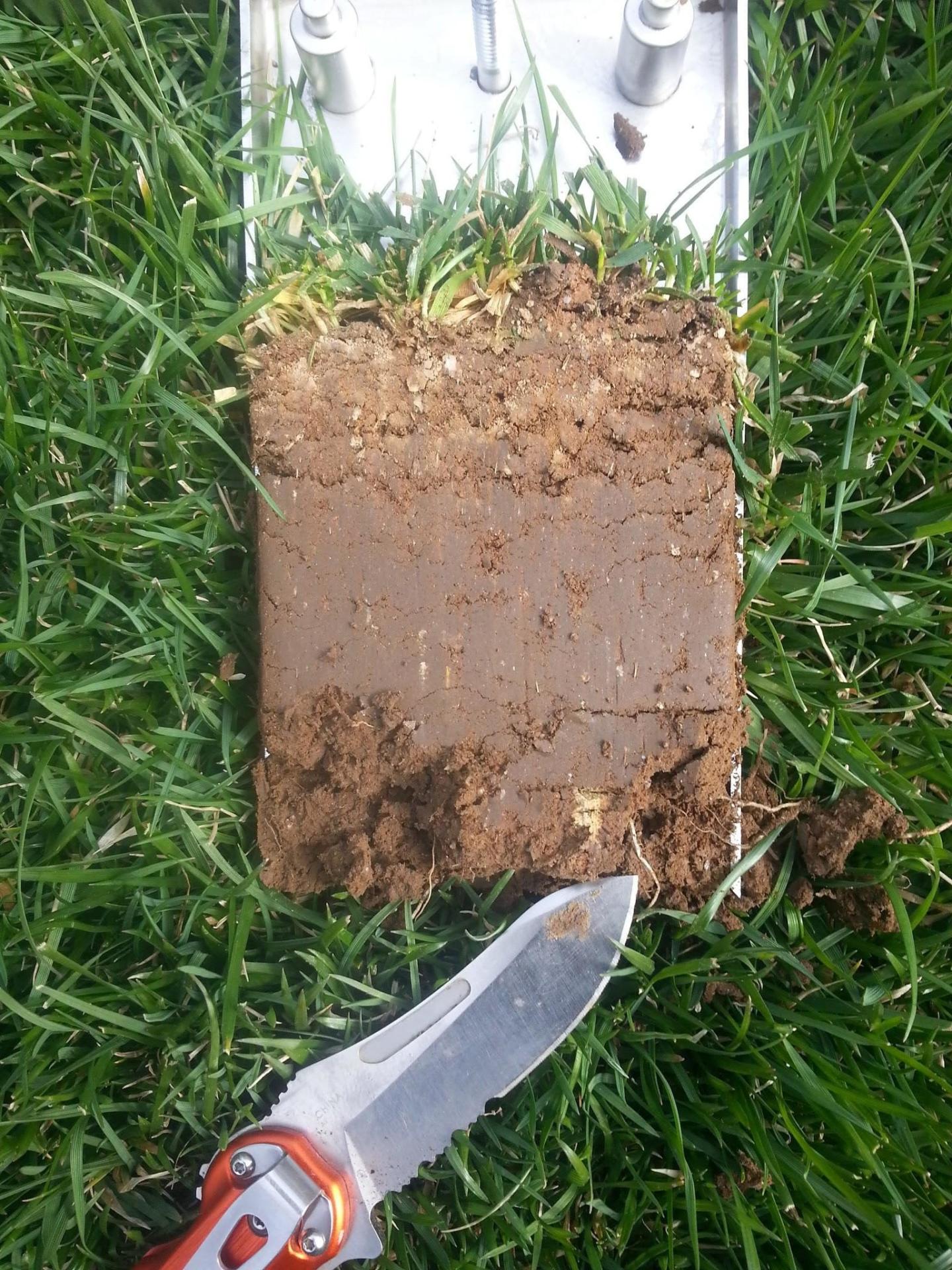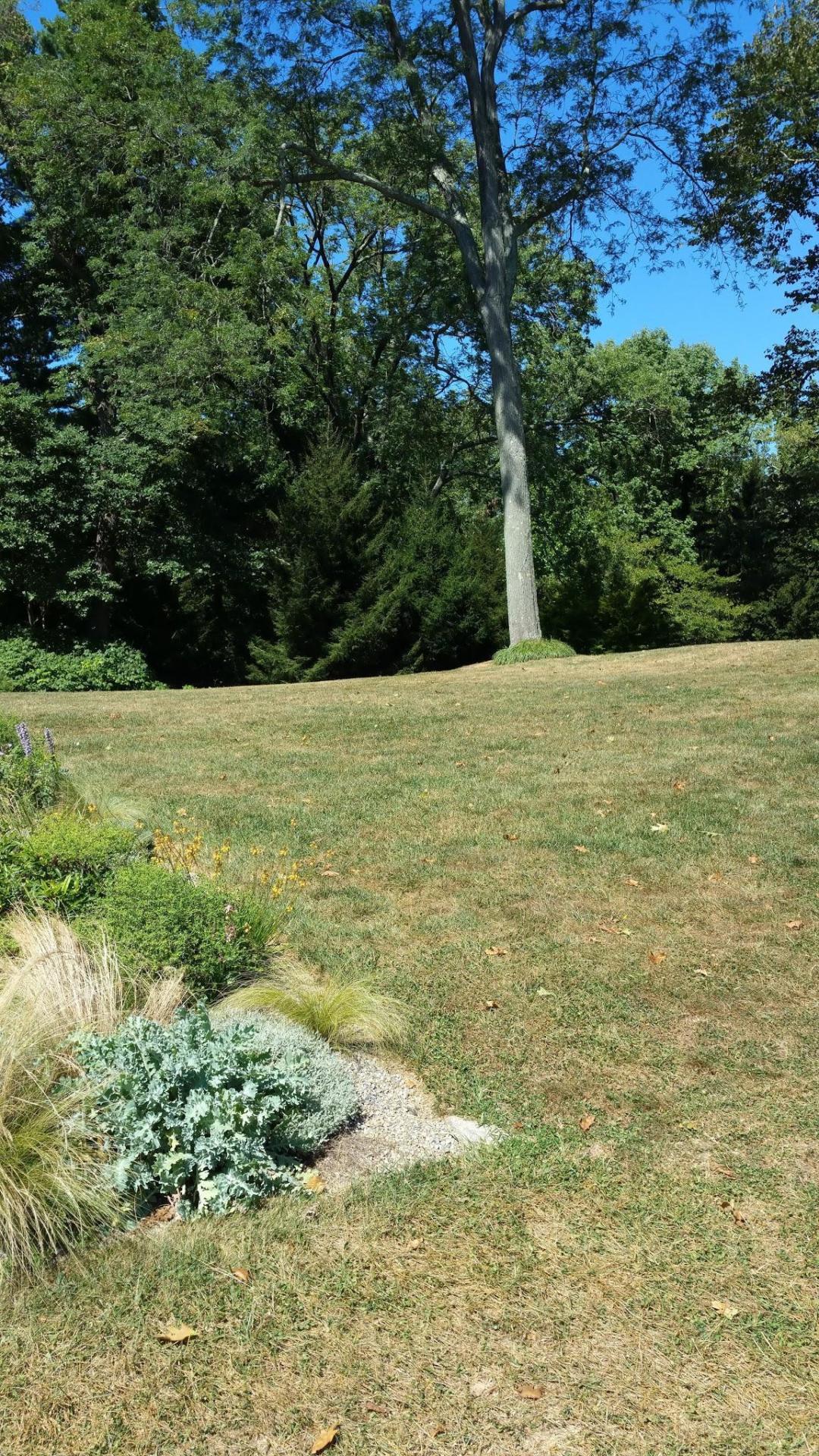by Scott Steinfeldt
Chanticleer is a public garden located in Wayne, Pennsylvania. It is a garden of pleasure and learning, relaxing yet filled with ideas to take home. As the home of the Rosengartens, Chanticleer was beautiful and green with impressive trees and lawns. Most of the floral and garden development you see today has occurred since 1990, designed by Chanticleer staff and consultants. Overall, The Chanticleer Foundation owns 47 acres, 35 of which are open to the public.
The lawns at Chanticleer serve a few functions. One, they provide a surface for our guests to walk, picnic, relax, and play on. Two, the lawns help connect one garden area to the next. Three, they are a filtering system for the environment, especially in capturing silt and sediment from stormwater.
Tending the Soil

Using a soil profile sampler, you can more clearly see what you are working with and how the roots are developing.
In managing the lawns, it is important to know what you are working with beneath one’s feet. Having a healthy soil is the foundation for everything else. Taking soil samples of the lawns is an annual practice. Soil samples are taken for a few reasons:
- Soil Chemistry tests show nutrient levels in the soil, soil pH and, cation exchange capacity.
- Soil Textural analysis provides the percentages of clay, silt, and sand that the soil is made up of. Based on the percentages a textural classification will be given.
- Soil Biology tests provide the breakdown of organisms that are in the soil.
The soil reports are tools that aid me in developing the nutrient program for the lawns.
Once you know the type of soils you are working with, it is important to then survey the environments that the grasses will be growing under: full sun, part sun, full shade, level ground versus sloped terrain, north-facing slope versus a south-facing slope, and a low foot traffic area versus a high traffic area.
At Chanticleer, we work with all of these different types of micro-environments. One of the most important points in dealing with any of these environments is oxygen. Aerification is the process of opening up the soil through mechanical means to allow infiltration of water and oxygen in the soil and to promote root growth. Aerification is also a way to reduce compaction, create a seed bed, break up thatch accumulation, and improve drainage. Whether through large tine spiking, hollow tine coring, or solid tine coring, aerification is the most important cultural practice performed on the property. For instance, the large tine spiking attachment for our tractor allows us to use it when the soils are either too wet or too dry. The slit or slice that is made allows for saturated soils to dry out, improving oxygen to the roots. It also provides an opening for rain water to infiltrate the soil when conditions get too dry. This practice of spiking or slicing is done on a monthly basis during the growing season.
Mowing Practices
At Chanticleer, only five percent of the lawns have an in-ground irrigation system. The remaining 95 percent of the lawns are managed in ways that minimize any additional stress on the grass. The biggest stress that can be put on the turf would be from cutting too low. The lowest cut on the grounds is three inches. Cutting the grass at 3” helps in promoting deeper roots, shading out emerging weeds, and promoting a healthier grass plant. During the summer months, the height of cut will be raised to 3½” and 4”, on sections that are southward facing slopes. When conditions get too dry, mowing is restricted and drought-induced dormancy is allowed.

In September 2016 after about seven weeks with no rainfall, this lawn is in drought-induced dormancy.
Having properly sharpened mower blades goes hand in hand with mowing height of cut. A sharp mower blade makes for a cleaner cut then a dull blade. A dull blade will cause a tearing action. The tearing of the grass blade creates a wound that takes longer to heal. The tear is an entry point for a pathogen and creates an aesthetic issue (grass blade looks white at the tip).
When mowing the lawns, the clippings are returned back to the grass canopy. During the fall months, leaf debris from the trees is mulched back into the grass canopy. The leaves provide a source of nutrients to the grass as they break down over the winter and spring months. The lawns are mowed when the grass is mainly dry. We try to avoid mowing in wet conditions, like heavy dew or rain, as much as possible.
From an aesthetics point of view, mowing with a piece of equipment that has a roller option can be very beneficial. The two pictures below were taken at different times of the year: late March and early August. The roller provides the nice striping design, while still maintaining a healthy height of cut: 3” in March and 3.5” in August.
Seeds and Seeding
Seeding is a critical part of any lawn care program. Knowing the type of conditions that the grass plant will be growing in is key to selecting the right plant for the right location. For the Philadelphia area, there are both cool and warm season grass plants to choose from. For the warm season plants, zoysia and Bermuda grass are the primary cold tolerant species for this region. The cool season grass species are Kentucky bluegrass, perennial ryegrass, bentgrass, tall fescue, and fine leaf fescues. Each species have its benefits and limitations, for example, fine leaf fescues are better suited to shady environments; however, they do not tolerate heavy foot traffic.
When selecting for grass species, one should access the National Turfgrass Evaluation Program (NTEP) website. This site provides evaluation of turf grass species in various climatic regions in the United States. NTEP evaluates the grasses on many characteristics: spring greenup, seedling vigor, disease and insect resistance, drought tolerance, traffic tolerance, and more. From this information, you can then find seed vendors that supply the species mix that is desired.
For the majority of the large lawn areas at Chanticleer, turf type tall fescues have been selected as the desired grass species to overseed. The turf type tall fescues are able to root deep, tolerant of drought and tolerant of most fungal diseases. In the shady areas without traffic, we are transitioning to fine leaf fescues. For the heavy traffic areas, perennial ryegrass, tall fescue, and Kentucky bluegrass are selected for their ability to tolerate foot traffic.
In general, overseeding of the lawns occurs in late August and early September.
Nutrients
The nutrient program focuses on providing the elements that are lacking from the soil chemistry report with a combination of ingredients that will feed and promote the biological organisms that are in soil. For example, in the large turf sections, nitrogen is applied at a rate of 2.5 to 3 lb. of nitrogen per thousand square feet per year. The 2.5 to 3 lb. is broken down into four applications throughout the growing season. We located and applied an organic-based fertilizer that provided only nitrogen because in this specific area, no phosphorus or potassium application was necessary based on the soil chemistry reports. In conjunction with fertilizer applications, a usable humate source with carbon is applied to stimulate biological organisms in the soil.
Typical organic-based fertilizers are derived from plant and animal meal by products. These products are geared to promoting activity within the soil biology, which in turn aids in the breakdown and uptake of the nutrients into the grass plant.
Pest Control
When dealing with pest control issues, an IPM approach has been used on the property. Scouting and mapping is done routinely.

Mapping can be as simple as sketching out the site, or using a map to make notes about a pest issue.
Having documentation of the pest issue, severity of infestation, and location help in developing a program to address the issue. Reduced-risk pesticides are selected to use, for example beneficial nematodes have been applied to control white grubs instead of insecticides that may pose a danger to non-target beneficials like bees. When dealing with weeds, burning, hand weeding, overseeding, and the use of reduced risk herbicides are employed.
In closing, when developing a lawn program for your site, the foundation is the key to development, just as it is in building construction. Only our foundation is the soil and its health. A comprehensive program will incorporate many different factors: soil sampling, environments, cultural practices, nutrient management, IPM, species selection, labor, and budget. The result will be a resilient, beautiful lawn.
About the Author
Scott Steinfeldt is the Assistant Grounds Manager at Chanticleer. He has worked at Chanticleer for nine years. Prior to his time at Chanticleer, Scott worked as a Golf Course Superintendent for five years. He holds a BS in Turfgrass Management from Penn State University and a BS in Business Management from Canisius College. Scott’s area of focus at Chanticleer is turf management, compost operations, and material handling needs for the garden.
***
Each author appearing herein retains original copyright. Right to reproduce or disseminate all material herein, including to Columbia University Library’s CAUSEWAY Project, is otherwise reserved by ELA. Please contact ELA for permission to reprint.
Mention of products is not intended to constitute endorsement. Opinions expressed in this newsletter article do not necessarily represent those of ELA’s directors, staff, or members.





